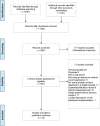Toward a Learning Health Care System: A Systematic Review and Evidence-Based Conceptual Framework for Implementation of Clinical Analytics in a Digital Hospital
- PMID: 35388447
- PMCID: PMC8986462
- DOI: 10.1055/s-0042-1743243
Toward a Learning Health Care System: A Systematic Review and Evidence-Based Conceptual Framework for Implementation of Clinical Analytics in a Digital Hospital
Abstract
Objective: A learning health care system (LHS) uses routinely collected data to continuously monitor and improve health care outcomes. Little is reported on the challenges and methods used to implement the analytics underpinning an LHS. Our aim was to systematically review the literature for reports of real-time clinical analytics implementation in digital hospitals and to use these findings to synthesize a conceptual framework for LHS implementation.
Methods: Embase, PubMed, and Web of Science databases were searched for clinical analytics derived from electronic health records in adult inpatient and emergency department settings between 2015 and 2021. Evidence was coded from the final study selection that related to (1) dashboard implementation challenges, (2) methods to overcome implementation challenges, and (3) dashboard assessment and impact. The evidences obtained, together with evidence extracted from relevant prior reviews, were mapped to an existing digital health transformation model to derive a conceptual framework for LHS analytics implementation.
Results: A total of 238 candidate articles were reviewed and 14 met inclusion criteria. From the selected studies, we extracted 37 implementation challenges and 64 methods employed to overcome such challenges. We identified common approaches for evaluating the implementation of clinical dashboards. Six studies assessed clinical process outcomes and only four studies evaluated patient health outcomes. A conceptual framework for implementing the analytics of an LHS was developed.
Conclusion: Health care organizations face diverse challenges when trying to implement real-time data analytics. These challenges have shifted over the past decade. While prior reviews identified fundamental information problems, such as data size and complexity, our review uncovered more postpilot challenges, such as supporting diverse users, workflows, and user-interface screens. Our review identified practical methods to overcome these challenges which have been incorporated into a conceptual framework. It is hoped this framework will support health care organizations deploying near-real-time clinical dashboards and progress toward an LHS.
Thieme. All rights reserved.
Conflict of interest statement
None declared.
Figures




References
-
- Charles D, Gabriel M, Furukawa M F.Adoption of electronic health record systems among U. S. non -federal acute care hospitals: 2008–2015Accessed October 7, 2021 at:https://www.healthit.gov/sites/default/files/briefs/2015_hospital_adopti...
-
- Oaten J, Stayner G, Ballard J.Baby deaths: hospital failures: an independent investigation has found a series of failures may have contributed to the deaths of 7 babies at a regional Victorian hospitalAccessed July 21, 2021 at:https://search-informit-org.ezproxy.library.uq.edu.au/doi/10.3316/tvnews...
-
- Barnett A, Winning M, Canaris S, Cleary M, Staib A, Sullivan C. Digital transformation of hospital quality and safety: real-time data for real-time action. Aust Health Rev. 2019;43(06):656–661. - PubMed
Publication types
MeSH terms
LinkOut - more resources
Full Text Sources
Miscellaneous

